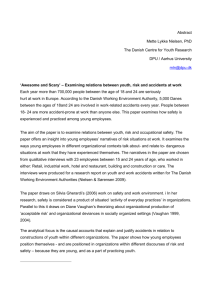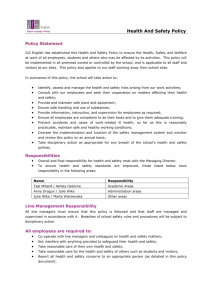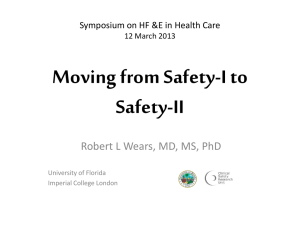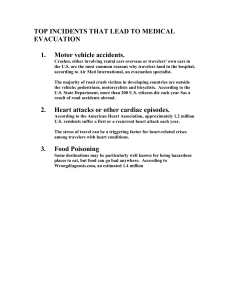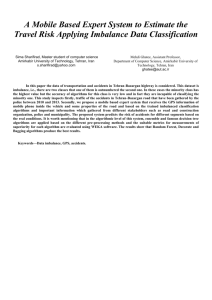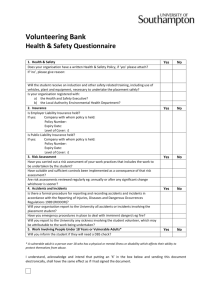Full text
advertisement
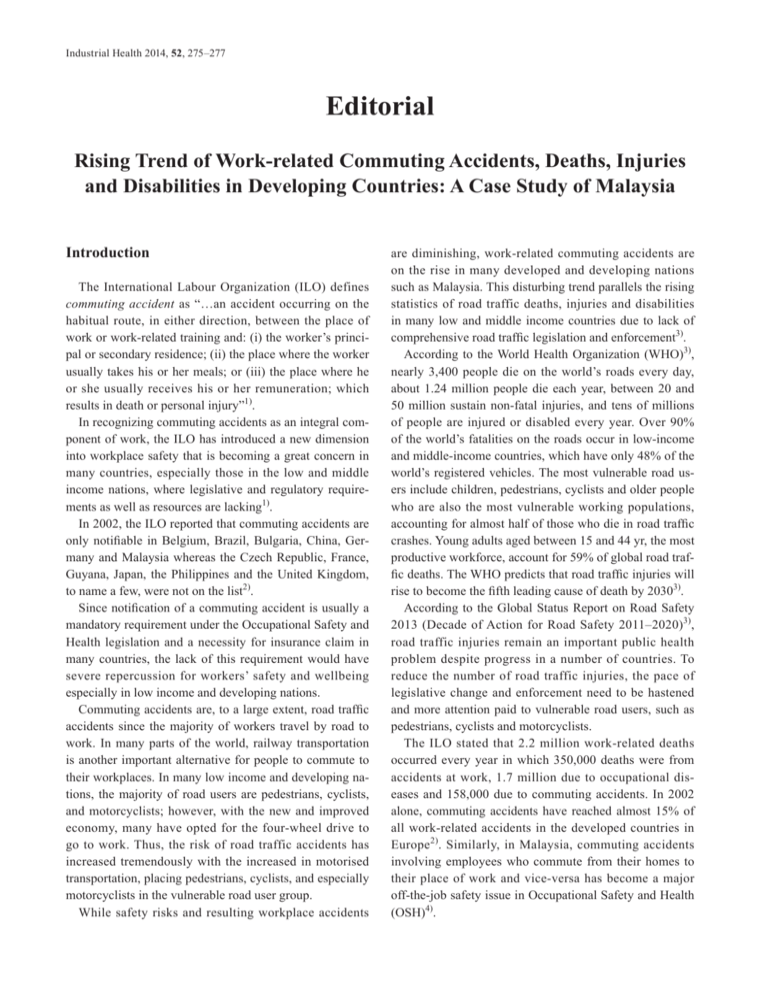
Industrial Health 2014, 52, 275–277 Editorial Rising Trend of Work-related Commuting Accidents, Deaths, Injuries and Disabilities in Developing Countries: A Case Study of Malaysia Introduction The International Labour Organization (ILO) defines commuting accident as “…an accident occurring on the habitual route, in either direction, between the place of work or work-related training and: (i) the worker’s principal or secondary residence; (ii) the place where the worker usually takes his or her meals; or (iii) the place where he or she usually receives his or her remuneration; which results in death or personal injury”1). In recognizing commuting accidents as an integral component of work, the ILO has introduced a new dimension into workplace safety that is becoming a great concern in many countries, especially those in the low and middle income nations, where legislative and regulatory requirements as well as resources are lacking1). In 2002, the ILO reported that commuting accidents are only notifiable in Belgium, Brazil, Bulgaria, China, Germany and Malaysia whereas the Czech Republic, France, Guyana, Japan, the Philippines and the United Kingdom, to name a few, were not on the list2). Since notification of a commuting accident is usually a mandatory requirement under the Occupational Safety and Health legislation and a necessity for insurance claim in many countries, the lack of this requirement would have severe repercussion for workers’ safety and wellbeing especially in low income and developing nations. Commuting accidents are, to a large extent, road traffic accidents since the majority of workers travel by road to work. In many parts of the world, railway transportation is another important alternative for people to commute to their workplaces. In many low income and developing nations, the majority of road users are pedestrians, cyclists, and motorcyclists; however, with the new and improved economy, many have opted for the four-wheel drive to go to work. Thus, the risk of road traffic accidents has increased tremendously with the increased in motorised transportation, placing pedestrians, cyclists, and especially motorcyclists in the vulnerable road user group. While safety risks and resulting workplace accidents are diminishing, work-related commuting accidents are on the rise in many developed and developing nations such as Malaysia. This disturbing trend parallels the rising statistics of road traffic deaths, injuries and disabilities in many low and middle income countries due to lack of comprehensive road traffic legislation and enforcement3). According to the World Health Organization (WHO)3), nearly 3,400 people die on the world’s roads every day, about 1.24 million people die each year, between 20 and 50 million sustain non-fatal injuries, and tens of millions of people are injured or disabled every year. Over 90% of the world’s fatalities on the roads occur in low-income and middle-income countries, which have only 48% of the world’s registered vehicles. The most vulnerable road users include children, pedestrians, cyclists and older people who are also the most vulnerable working populations, accounting for almost half of those who die in road traffic crashes. Young adults aged between 15 and 44 yr, the most productive workforce, account for 59% of global road traffic deaths. The WHO predicts that road traffic injuries will rise to become the fifth leading cause of death by 20303). According to the Global Status Report on Road Safety 2013 (Decade of Action for Road Safety 2011–2020)3), road traffic injuries remain an important public health problem despite progress in a number of countries. To reduce the number of road traffic injuries, the pace of legislative change and enforcement need to be hastened and more attention paid to vulnerable road users, such as pedestrians, cyclists and motorcyclists. The ILO stated that 2.2 million work-related deaths occurred every year in which 350,000 deaths were from accidents at work, 1.7 million due to occupational diseases and 158,000 due to commuting accidents. In 2002 alone, commuting accidents have reached almost 15% of all work-related accidents in the developed countries in Europe2). Similarly, in Malaysia, commuting accidents involving employees who commute from their homes to their place of work and vice-versa has become a major off-the-job safety issue in Occupational Safety and Health (OSH)4). 276 Commuting Accidents in Malaysia There is a general trend indicating that industrial accidents are on the decline in Malaysia. However, the number of commuting accidents has increased by almost 49% in the past 6 yr from 17,682 accidents in 2007 to 26,262 in 20124). Studies by the Social Security Organization (SOCSO) in collaboration with local universities showed that 88% of accidents occurred while commuting to and from work. The survey also found that 68.8% of cases involved employees who work in the morning and 55% of accidents occurred within less than 5 km from their workplaces5). The problems related to the rising number of commuting accidents are lack of awareness among workers about safe riding and driving; lack of comprehensive training programs targeted at commuting accidents; lack of commuting safety management and lack of road safety elements in OSH management systems at workplaces4). The number of road fatalities in Malaysia is alarming. There are more than 6,000 fatalities every year and that translates into 18 to 20 people killed every day. Based on the autoregressive integrated moving average (ARIMA) prediction model by researchers in the Malaysian Institute of Road Safety Research (MIROS), the predicted road fatalities for 2015 are more than 8,000 and for 2020 there will be more than 10,000 fatalities6). Since 1992, motorcyclists and pillion riders make up about 60% of fatalities and most of them are young and in the prime of their lives. Data from MIROS indicated that there was an increasing trend of severe injury and death among motorcyclists from 2000 to 20106). Statistics from the Royal Malaysian Police show that at least 15% of total motorcycle fatalities in the country occurred in Selangor, the most developed state after the capital city of Kuala Lumpur in 2006 until 2009. Focusing on motorcyclists killed and seriously injured in Selangor, for year 2007 and 2008, data illustrates the highest is in the district of Klang, followed by Petaling Jaya7). According to the SOCSO data, there were three work-related deaths every day in 2011 alone. Two of the three were due to commuting accidents, indicating a serious situation in the country4). Impact of Commuting Accidents on the Nation The increasing number of accidents involving Malaysians commuting to work has seen the SOCSO paying out a staggering Ringgit Malaysia (RM) 720 million compensation in the last one and the half years of 2011. A total of RM400 million was paid out to SOCSO contributors in 2010, while up till June of 2011, RM320 million was disbursed. A large portion of the compensation was disbursed to motorcyclists who suffered serious injuries as a result of accidents. According to the Ministry of Human Resources, the number of motorcyclists being involved in accidents keeps increasing and this is attributed to a lack of prevention, particularly self-safety4). Between January and June of 2012, 30,575 accident cases were reported to SOCSO. This represented an increase of 3% from 29,629 cases recorded in 2011. The number of commuting accidents between January and June also saw an increase to 12,893 cases, up 5.6% from the 12,209 cases in the same period in 2012. Data on human costs (in terms of death, injuries, sufferings, impact on the family and community) and potentially decreased productivity have not been researched extensively4). Prevention and Control of Commuting Accidents Through Self-regulation The Commuting Accident Prevention Plan introduced by the National Institute of Occupational Safety and Health in 2011 aims to prevent commuting accidents through the implementation of four programs: Commuting Accident Outreach Program for Employers and Employees; Safe Motorcycle Riding Program and Defensive Driving Program; Applied Research Grants; and, establishing the Commuting Safety Management System/Road Safety Element in the OSH Management System8). Through self-regulation, employers have a moral obligation to adopt a proactive approach to managing occupational road risk and can change the driving attitude and behavior of their employees. They can help devise safe journeys and provide training to prevent road accidents. Employers also have a duty to protect their employees and other road users by managing road risk controlling significant business losses that arise from accidents, including direct accident costs, lost staff time, higher insurance premiums and poor public image. Companies that take action to promote the safety of their staff while driving will achieve major cost savings and improve their image and make a significant contribution to meeting road safety targets. Employers who are concerned with the safety and wellbeing of their employees can help address the problem of commuting accidents by introducing and implementing comprehensive and sustainable training programs that focus on commuting accidents and commuting safety management8). Industrial Health 2014, 52, 275–277 277 Conclusion Commuting accidents are increasingly recognized to pose a severe and significant burden to the economic and social wellbeing of Malaysia through loss of critical manpower and productivity. The government needs to seriously consider the fact that there is no single authority to enforce the commuting accident prevention programs. Employers have the responsibility to protect their employees and other road users through proper management of road risks that will also control significant business losses. Employees have the responsibility to comply with all road traffic laws and regulations as well as all written policies, procedures and training developed by their employers to prevent and reduce commuting accidents. References 1) ILO. World Social Security Report 2010/11. http://www.ilo. org/wcmsp5/groups/public/—dgreports/—dcomm/—publ/ documents/publication/wcms_146566.pdf. Accessed June 30, 2014. 2) I L O . R e p o r t V ( 1 ) R e c o r d i n g a n d n o t i f i c a t i o n o f occupational accidents and diseases and ILO list of occupational diseases. http://www.ilo.org/public/english/ standards/relm/ilc/ilc90/rep-v 1.htm#Commuting%20 accidents. Accessed June 30, 2014. 3) WHO. Global Status Report on Road Safety 2013: Supporting a Decade of Action. WHO: Geneva. 4) SOCSO. Annual Report. http://www.perkeso.gov.my/en/ report/annual-reports.html. Accessed June 30, 2014. 5) UITM/SOCSO/MSOSH Study. Study on Commuting Accidents. www.mysafetyandhealth.com/2012_02_01_ archive.html. Accessed June 30, 2014. 6) MIROS MRR 05/2012: MIROS Crash Investigation and Reconstruction Annual Statistical Report 2007–2010. http:// www.miros.gov.my. Accessed June 30, 2014. 7) MIROS MRR 06/2012: Research Report: Predicting Malaysian Road Fatalities for Year 2020. http://www.miros. gov.my. Accessed June 30, 2014. 8) Lee LT. The Commuting Accident Prevention Plan. The Star Online. http://www.thestar.com.my. Accessed June 30, 2014. Rusli Bin Nordin Jeffrey Cheah School of Medicine & Health Sciences, Monash University, Malaysia


